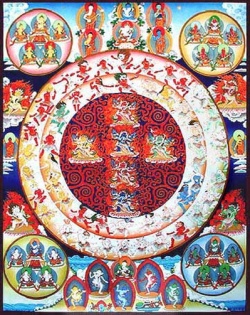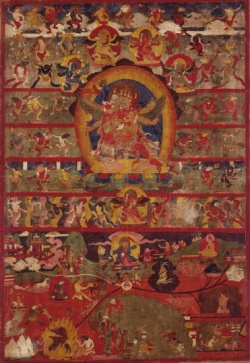The Bardo: Web Version
By Cathleen Cummings
26 May, 1998
The Tibetan Book of the Dead, or Bardo Thodol, is one of the fundamental texts of Tibetan Buddhist practice. A self-contained
doctrine, the book whose title more accurately translates as The Great Liberation Through Hearing in the Between -- stands in its own category of Tibetan literature. The Bardo, or Between, is the postdeath plane of existence wherein one's enduring consciousness wanders between the end of this life and the next rebirth. The experiences of each
individual consciousness drifting in the Bardo realm -- the visions that confront him and the condition of his liberation or eventual rebirth -- are determined by the spiritual effects of karmic accumulation resulting from his own particular life's deeds.
Every individual undergoes a journey through the Bardo during which the consciousness of each is clothed in a subtle body, one that resembles the body of his future rebirth. For some, the journey is very short; for others it can last up
to forty-nine days. The experience of each individual in the Bardo, and the length of time one spends there, is dependent upon one's understanding of the processes of death and dying, and the training for death that is undertaken during life. For the practitioner who has been trained in deity yoga and has achieved the ability to recognize
the Clear Light of death that manifests during the first three-and-a-half days following the death experience, enlightenment is easily achieved. This stage of Clear Light is known as the Chikhai Bardo, or the experience of death, and the Clear Light is the vision of the radiant dharmakaya, the Uncreated, Essential Wisdom which is the essence of
the Universe in which both incarnated existence (samsara) and nirvana exist. The adept practitioner simply recognizes that this Clear Light is in reality the nature of his own mind: the fundamental mind that exists without beginning in each person throughout all his lifetimes and into his Buddhahood, and is therefore
synonymous with the mind of a Buddha. Realizing this, the experienced practitioner achieves the state of a Dharmakaya Buddha.
The consciousness of the individual who passes through these first few days of Clear Light without recognizing it and attaining enlightenment is confronted by powerful and confusing visions and sensations. That consciousness enters the second stage of the Bardo, called the Chonyid Bardo, or experience of reality, where the Peaceful and [[Wrathful
deities]] manifest themselves. The individual with some training, who can recognize these images as products of his own mind, can turn their appearance to his advantage. Realizing that these beings are but products of his mind, the
consciousness of the deceased can join itself with them and become an enlightened being of the sambhogakaya. Alternately, by focusing on and praying to one of these Peaceful or Wrathful beings, the consciousness can take rebirth in that deity's Pure Land (or Paradise) to study Dharma and meditative techniques.
Most commonly, one's consciousness will dwell some seven days in the Bardo before achieving liberation through understanding that the true nature of the Bardo is the nature of the fundamental mind. For him with little or no training or preparation for death, however, the fearful nature of the Bardo visions prevents understanding and subsequent
release. Unliberated, his consciousness reacts negatively to the sensations and deity visions of the Bardo, with resulting negative emotions that drive him on into the third stage of the Bardo. Blown by the winds of karmic accumulation, and still feeling the bonds of attachment to a physical body, the individual is led back to an incarnated form in
one of the Six Realms of Existence. This seeking of the next physical body takes place in the Sidpai Bardo, the third stage of the postdeath intermediate state. This search involves a symbolic journey into Hell where Dharmaraja, the Judge of Death, weighs the good and bad karmic deeds of each individual to determine his appropriate rebirth realm.
The text of the Bardo Thodol with accompanying initiations is recited to the deceased by a monk, Lama or other ritual specialist. The Bardo Thodol text is read to the deceased for at least a fortnight following death. It explains to the
consciousness of the deceased the nature of the various deities he will encounter on the Bardo plane and reminds him to remain steadfast and unafraid since these visions have no reality or external existence: the Bardo visions are only his own thought-forms taking manifested shape. At every moment the Lama urges the deceased not to succumb to terror in fear of
the deity visions of the Bardo, but instead to recognize these figures as his own projections, as in a dream; to recognize that the cosmic deity mandalas unleashed by the dying process are no more than a reflection of his own interior reality.
Although the Bardo Thodol is part of the more rigorous Tantric or Vajrayana Buddhist tradition, with its particular methods for attaining instantaneous enlightenment, it is also a popular manual intended for the Tibetan layperson who may not be knowledgeable in yogic meditational practice; so, it's teachings encompass the gamut of Tibetan Buddhist practice.
Descriptions of the Bardo deities and initiations are included in several works found on this site. Catalogue number (75/97.071) is a thankg-ka in which are shown all of the Peaceful and many of the Wrathful deities. Catalogue number (76/92.053) is focused on one such Wrathful deity, Vajra-Heruka, who is surrounded by the Wrathful counterparts of the male and female
Bodhisattvas. Also included here (#91.001.004) are an incomplete set of tsakalis, small initiation cards which are used in the performance of the Bardo initiations.
References:
W. Y. Evans-Wentz, The Tibetan Book of the Dead. 1927. Reprint: Oxford University Press, 1960.
Detlef Ingo Lauf, Secret Doctrines of The Tibetan Books of the Dead. Boulder: Shambhala Publications, 1977.
Venerable Lama Lodo, with Foreword by Kalu Rinpoche, Bardo Teachings: The Way of Death and Rebirth., Ithaca,
New York: Snow Lion Publications, 1982.
John Powers, Introduction to Tibetan Buddhism. Ithaca, New York: Snow Lion Publications, 1995.
Robert A. F. Thurman, The Tibetan Book of the Dead. New York: Bantam Books, 1994.
David Germano, "Dying, Death, and Other Opportunities".

